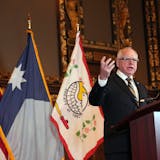Minneapolis Fed President Neel Kashkari, just a week after his first vote on the nation's interest rates, published an online essay explaining it, an unusual move for a member of the central bank's policy committee.
Kashkari wrote in the Tuesday blog that he voted with the broader panel last Wednesday to keep the federal funds rate steady, because inflation is in check and the U.S. economy is not at maximum employment.
Higher inflation and full employment are signals of an overheating economy, which the Fed panel would seek to cool by raising rates.
The Federal Reserve's rate-setting Open Market Committee, or FOMC, in late 2015 ended seven years of near-zero interest rates with a quarter-point increase, then held off for most of last year before making another quarter-point move in December.
Kashkari, who this year gets a vote on the panel as part of a rotation with other leaders of regional Fed banks, has written several blog posts on the Medium.com website in recent months and took to the site again with the explanation of his first vote.
Kashkari wrote the essay to "enhance transparency" of the Fed "without adding to the cacophony," a nod to the oft-followed speeches and events involving Fed officials around the country.
"Rather than predicting what will happen next, I am explaining why I voted the way I voted as a case study," he wrote.
It wasn't clear whether Kashkari will write an essay after every vote during his time on the FOMC. There are seven more this year. He wasn't available for comment Tuesday, a bank spokeswoman said.



